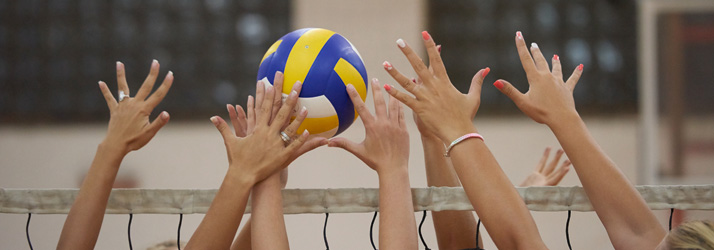Low Back Pain, Facet Compression, Stress Fracture and Volleyball: What You Need to Know in Thousand Oaks CA
Low Back Pain, Facet Compression, Stress Fracture and Volleyball: What You Need to Know in Thousand Oaks CA

For those of you that don't know we have been training and working with volleyball players in Thousand Oaks CA for over 25 years. We currently train many volleyball teams here at Complete Performance Center. Ryan Denihan Complete Performance Center's Head Athletic Trainer played collegiately, and I have been playing volleyball since my high school. And as both of us know low back pain is a common complaint among many volleyball players. The latest studies reveal it is common for volleyball players to experience lower back pain at some point in their career. While low back pain in Thousand Oaks CA can be caused by a wide range of factors such as poor posture, muscle strain, or degenerative disc disease; it is particularly relevant in athletes who engage in high-impact sports such as volleyball.
Definition of Low Back Pain in Thousand Oaks CA
Low back pain can be classified based on its onset and duration. Acute low back pain lasts for less than six weeks and typically results from a sudden hyper extension or hyper extension with twisting. Chronic low back pain persists for more than three months and may be caused by structural changes in the spine due to overuse, excessive torquing of the spine or disc degeneration.
Symptoms of low back pain can vary widely between individuals but may include stiffness, muscle spasms, shooting pains down one or both legs (sciatica), and difficulty standing up straight or leaning back. The severity of symptoms can range from mild discomfort to debilitating agony that significantly affects ones quality of life.
Causes of Low Back Pain
The causes of low back pain are numerous but athletes who engage in high-impact sports like volleyball are also at increased risk due to repetitive strain injuries caused by jumping, hyper extension, amd running on hard surfaces.
Other risk factors for low back pain include age-related wear and tear on spinal joints (osteoarthritis), herniated discs (slipped discs), spinal stenosis (narrowing of the spinal canal), and spondylolisthesis (slippage of one vertebra over another) or a stress fracture of the lower lumbar spine. These conditions can lead to nerve compression, which causes pain, numbness, and weakness in the lower back and legs.
Importance of Understanding Facet Compression and Stress Fracture in Volleyball Players
The two things we see the most of are Facet compression and stress fractures. These two conditions can occur in volleyball players due to the repetitive high-impact nature of the sport. Understanding these conditions is crucial as they can cause significant pain and discomfort, leading to loss of playing time or even forced retirement from athletics.
Facet compression occurs when the facet joints in the spine become compressed due to repetitive impact on hard surfaces. This can cause inflammation, stiffness, and pain that radiates from the lower back down to the buttocks or legs.
Stress fractures are small cracks that develop in bones due to repetitive strain caused by jumping or running on hard surfaces such as gym floors. In volleyball players, stress fractures commonly occur in the vertebrae of the lower back (lumbar spine), causing significant pain and difficulty moving. By understanding these conditions and their causes, athletes can take steps to prevent them through proper training techniques such as core strengthening exercises, rest periods between games/practices, wearing appropriate footwear with good cushioning support when playing on hard surfaces like concrete courts.
Prevalence of Low Back Pain in Volleyball Players
Low back pain is a common complaint among athletes, including volleyball players. In fact, studies show that low back pain is one of the most common musculoskeletal complaints among volleyball players, affecting up to 58% of players at some point during their careers. This high prevalence of low back pain is likely due to the repetitive jumping and landing movements involved in volleyball, as well as the constant twisting and turning required to make to spike, and quick movements on the court.
In some cases, low back pain may be exacerbated by poor technique or improper training methods, which can place excessive strain on the spinal structures. This underscores the importance of proper training and technique when it comes to preventing low back pain in volleyball players. Here at Complete Performance Center, we pride ourselves on creating strength training programs for our athletes to address these concerns.
Facet Compression and Stress Fracture in Volleyball Players
Facet compression is a condition where the facet joints in the spine become compressed, leading to pain, stiffness, and reduced mobility. The facet joints are located on each side of the vertebrae and function to provide stability to the spine while also allowing for movement.
When these joints become compressed, they can cause pressure on surrounding nerves, leading to pain in the lower back. Stress fractures occur when there is an overload of stress on a particular area of bone that is unable to withstand that stress.
In volleyball players, this commonly occurs in the lower back due to repetitive jumping, hyperextension of the lower back, and landing movements. Stress fractures can be difficult to detect at first because they may not show up on an x-ray until several weeks after the injury occurred. When a patient who is a volleyball player and has had lower back pain for over 4 weeks comes to Complete Performance Center, we will always suspect a stress fracture until proven otherwise.
Causes of Facet Compression and Stress Fracture
Facet compression can be caused by a variety of factors such as poor posture, muscle imbalances, or degenerative changes in the spine. In volleyball players specifically, facet compression can occur due to repetitive motions. Similarly, stress fractures are often caused by overuse injuries resulting from repetitive motions that place high amounts of stress on bones. When that stress can no longer be supported by the bone the joint/bone breakdown and a stress reaction will form. If that stress is not resolved of the player continues to play the overuse stress will causes a stress fracture in the lumbar spine.
In volleyball players specifically, this usually occurs due to repeated jumping, landing, twisting, and hyper extensions, actions during play without proper rest periods. Other risk factors for developing facet compression or stress fractures include age (older individuals have a higher risk), gender (women tend to have weaker bones than men), nutrition (a lack of calcium or vitamin D can lead to weaker bones), and genetics (some individuals may have genetic predispositions for bone disorders).
Symptoms and Diagnosis of Facet Compression and Stress Fracture
Symptoms of facet compression often include lower back pain that worsens with standing or movement, stiffness in the lower back, and reduced mobility. In more severe cases, nerve compression may result in shooting pain that radiates down the leg.
Symptoms of stress fractures usually include localized pain in the lower back that worsens with activity, tenderness when pressing on the affected area, and pain that improves with rest. To diagnose facet compression or stress fractures, our doctors at Complete Performance Center will perform a physical exam to evaluate range of motion and assess for areas of tenderness.
Imaging tests such as x-rays or MRI scans may be ordered to confirm a diagnosis and determine the severity of the injury. In some cases, a bone scan may be necessary to detect stress fractures that do not show up on x-rays immediately after an injury.
Risk Factors for Low Back Pain in Volleyball Players
I have identified several factors that can increase the prevalence of developing low back pain in volleyball players. These include age (older athletes may have increased risk), gender (female athletes may be at higher risk), overuse injuries (such as stress fractures or facet compression), poor conditioning or muscle weakness, and improper technique or training methods. By identifying these risk factors and taking steps to address them, coaches and athletic trainers can help prevent low back pain from occurring in their athletes.
Prevention Strategies for Facet Compression and Stress Fractures in Volleyball Players
Proper Training Techniques
One of the most important prevention strategies for facet compression and stress fractures in volleyball players is ensuring proper training techniques. Volleyball requires a lot of jumping, landing, twisting, and sudden changes in direction which can cause stress on the lower back. Coaches and trainers should ensure that players are using proper techniques to execute these movements, such as landing on two feet with soft knees to absorb the impact of a jump.
Additionally, players should be trained to engage their core muscles throughout all movements to provide added stability to the spine. It is also important to gradually increase the intensity and volume of training over time.
Building up endurance and strength slowly allows the body to adapt and become better equipped to handle the stress of repetitive movements. This can help reduce the risk of developing facet compression or stress fractures from overuse.
Core Strengthening Exercises
Core strengthening exercises are crucial for preventing facet compression and stress fractures in volleyball players. A strong core provides stability for the spine during dynamic movements like jumping, landing, and twisting. There are many exercises that can be done to improve core strength, such as planks, side planks, Russian twists, super mans, and bird-dogs.
Incorporating these exercises into a regular training routine can help strengthen not only the abdominal muscles but also other muscles in the trunk like the erector spinae group which helps support spinal extension. Stronger trunk muscles will help distribute forces more evenly across your entire body when performing high-impact activities like playing volleyball.
Rest and Recovery
Rest is essential for preventing facet compression and stress fractures in volleyball players. Volleyball requires a lot of repetitive movement patterns that place stress on certain areas of your body over time. Taking breaks from training or competition allows time for your body to recover and repair any damage before it becomes a bigger issue.
In addition to rest, recovery practices such as stretching, massage, or foam rolling can also aid in injury prevention. These practices help increase blood flow to the affected areas and reduce muscle tension, helping to prevent the development of chronic lower back pain.
Consistent rest and recovery practices should be incorporated into every player's training routine, even during periods when they are not experiencing any pain or discomfort. The goal is always proactive prevention rather than reactive remedies.
Significance of Understanding the Relationship between Low Back Pain, Facet Compression, Stress Fractures, and Volleyball
Low back pain is a common problem in volleyball players. It can be caused by various factors such as poor technique, overuse of muscles, and improper training. Facet compression and stress fractures are two specific conditions that can result from repetitive impact to the spine during volleyball play.
Understanding these conditions is important for prevention and effective treatment of low back pain in volleyball players. Facet compression and stress fractures are often overlooked or misdiagnosed as general low back pain.
However, early recognition and treatment can prevent long-term complications such as chronic pain or disability. Additionally, knowledge of these conditions can help coaches and trainers develop effective prevention strategies for their athletes.
If you are suffering from lower back pain don’t hesitate to call our office Complete Performance Center. We are here to help you with your lower back pain. Until next time have fun on the court and remember prevention is always the best medicine!
Monday
8:00am - 12:00pm
2:00pm - 6:00pm
Tuesday
8:00am - 12:00pm
2:00pm - 6:00pm
Wednesday
8:00am - 12:00pm
2:00pm - 6:00pm
Thursday
Closed
Friday
8:00am - 12:00pm
2:00pm - 6:00pm
Saturday & Sunday
Closed

Complete Performance Center
101 Hodencamp Rd STE 103
Thousand Oaks, CA 91360




